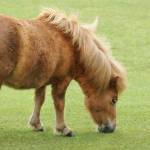Pasture and Endocrine-Related Laminitis in Horses

When a horse owner hears the word “laminitis,” it invariably conjures up feelings of dread and fear. Within the equine hoof, soft, finger-like structures called laminae are part of the essential support system that holds the hoof and coffin bone in place. When the laminae become damaged and inflamed, a condition known as laminitis, they become weak, leaving the coffin bone prone to rotation. Laminitis can be extremely painful and debilitating and is potentially fatal. Unfortunately, there is no effective cure or guaranteed prevention method.
A horse’s lifetime risk of developing laminitis is estimated to be about 15%. A survey conducted by the American Association of Equine Practitioners (AAEP) several years ago identified laminitis as a top priority for research. As a result, a Laminitis Research Working Group was developed. The most common causes of laminitis, pasture and endocrinopathy-associated lameness (PEAL), were studied first. The study identified laminitis cases, which were retrospectively traced to determine risk factors for the development of disease. Control groups included healthy animals and lameness controls (horses with front-end lameness that was not due to laminitis).
The primary result of the study found that gender, age, and frequency of exercise were not risk factors for the development of disease. Major risk factors for development of laminitis included exposure to lush pastures, high body condition score (overweight horses), the presence of endocrine disease (such as Cushing’s syndrome or equine metabolic syndrome), and horses who had received glucocorticoids within 30 days of onset of laminitis symptoms.
The good news is that several risk factors can be controlled, including body condition, glucocorticoid administration, and management of endocrinopathic disease. (Researchers on another project recently took a closer look at the supposed link between laminitis and the glucocorticoid prednisolone. Read more from that study.) This study provided more evidence that obese horses are at an increased risk for laminitis.
Changes in the pH of the hindgut due to alterations in the microbial populations and acid profiles cause a condition known as subclinical acidosis, which can put affected horses at a higher than normal risk for colic and laminitis. In research trials at Kentucky Equine Research (KER), EquiShure, a time-released hindgut buffer, prevented the decrease in pH associated with rapid starch and sugar fermentation after a large grain meal or fructan exposure, enabling lactate-utilizing bacteria to thrive and convert lactate into VFA. EquiShure is appropriate for all horses at risk of suffering from subclinical acidosis.
Unfortunately, laminitis is sometimes the first sign of endocrine disease. It is important to screen and manage endocrine disease as early as possible. Weight management of horses is crucial, and horse owners should become educated about the importance of managing body weight.
Diet tips for horses with metabolic conditions can be found in Nutritional Management of Metabolic Diseases, a 28-page booklet published by Kentucky Equine Research.








